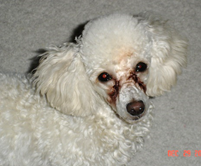Managing Expectation on Removing Tear Stains
At Eye Envy, we try very hard to explain how tear stains occur and what happens when animals tear.
Tears do not come out of the tear duct red in color or full of yeast. On the contrary, your pet tears,
causing the area beneath the eyes to become wet. Bacteria begins to form due to the moisture,
heat and added elements, such as dirt, minerals from water, food coloring, etc. The area under the
eyes forms a perfect breeding ground for a bacterial infection to begin and to grow. That is why
removing tear stains requires consecutive days of treatment and why so many people say, ‘I clean it
every day with water, but it doesn’t go away’. You’re basically adding more moisture to the area,
causing the bacterial to continue to grow.
Education is key in this area, because many people expect an instant miracle. Unfortunately, there
is no instant miracle and there never will be. An animal that tears, will usually always tear,
therefore, we need to teach pet owners how to clean the stains already there, then how to keep the
area clean and maintain the area stain free.
We like to show pet owner’s examples of before and after pictures of our customer’s, so they can
see that this is not an instant miracle and that the time to remove the stains can vary from a few
days to weeks. Each animal is different and there are many things that can contribute to the
staining. E.g. Excessive tearing, bulgy eyes, nervousness, the length of the snout, plus any
additional underlying issues like hair in the eyes, a scratch, etc.
We also tell our customers that each animal is different and so are their tear stains. Results can vary
depending on: how bad the stains are, how the stains have been treated in the past (e.g. bleach,
peroxide, whitening agents, etc.). Also, cats have fur vs. dogs have hair, so cats tear stains can be
removed within 1 to 2 days vs. dogs tear stains can take consecutive days and even weeks.
Examples from Clients:
T’Chelsea (Maltese) – 5 Days to Remove Stains




Gracie, Poodle – Two weeks to clean stains




Gabriel (Maltese) – Almost 5 weeks to clean stains (Our best, yet worse case customer)




Teaching pet owners that tear stains are an external problem, not an internal problem is also very
important. Ingesting antibiotics into your dog’s body on a daily basis is not the solution. Basically,
you are saturating the dog’s body with an antibiotic (most commonly used Tylosin, which is not FDA
approved for dogs and cats, but rather chickens and swine). Once your pet’s body becomes
saturated with antibiotics, when it tears, the tears are loaded up with antibiotics, therefore treating
the infected area. Depending on the size of your dog and the amount of tears it produces, depends
on the time it requires to work. Also, giving your pet an antibiotic on a daily basis can cause your
pet to build a resistance to antibiotics, plus it can change test values and also may cause teeth and
liver issues. Long term affect is something that customers need to be concerned with.
Pet owners should also know that the bacterial infection, if left untreated, can also cause the area
under the stains to become raw and even bleed. Pet Owners need to understand that the bacteria
is ‘eating’ away at the skin, therefore, not only is it smelly and ugly, but it’s also not healthy for their
pets. Cleaning the area with water is only adding to the problem. You must know how to
remove/clean and control the growth.
If your pet has been treated with any type of whitening, brighteners, cranberry, blueberry, bluing,
blue/violet colored shampoo or facials, these products mimic the properties of bleach and/or
peroxide. Therefore, they initially remove the stains, but they cause the hair to become porous.
The next time the area stains, those stains will set, making it almost impossible to remove the stain.
Eye Envy will only lighten the stain to a light pink. Use whitening shampoos/facials on every other
part of their pet’s body, EXCEPT for the stained area. Even if you’ve used these types of products in
the past, starting using Eye Envy will still help. Re-growth will be white, but the area that has been
treated with these types of products will only lighten to a light pink, at best.
Example: This is Mr. Wiggles, they used Puppy Whitening shampoo, as you can see the stains are
mostly gone, but there is a light pink discoloration. That hair shaft is ruined. Re-growth is white.


We would love nothing more than to tell you that your pet stains will go away immediately, but that just isn’t the case. What we ask is that you use the product daily until the stains are gone. Once the stains are gone, typically you can reduce to a maintenance mode of once or twice a week. Once again, varies by each dog. Also, if you’re dealing with a puppy, it may require fewer days in between cleaning, since they are teething.
Hope this helps make your precious baby look beautiful!!
To learn more about our products, visit our Eye Envy YouTube Channel!
